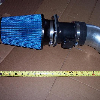EXPLDER
Well-Known Member
- Joined
- June 2, 2003
- Messages
- 109
- Reaction score
- 0
- City, State
- va
- Year, Model & Trim Level
- 91 xlt 4 sale, NEW 96 XLT
stock tire/stock ride height measurement
Hey guys, no this isn't yet another question about torsion twisting (well, ok it sorta is). I need to know what you guys have for stock ride heights. If you could measure from the ground to the top of your fender lip passing through the middle of your wheel OR measure from the very center of your wheel to the fender lip that would be great.
I think my truck sagged in the front, most have problems sagging in the rear, but mine was the opposite. The book (I think Chiltons) says to measure from the center of the lower arm bolt (the A-arm to frame/ bushing bolt) to the ground and measure from the lowest part of the steering knuckle (NOT the ball joint) then subtract the two. They list 3.25~3.75 for standard explorers and 3.5~4.5 for the air adjust models. I got a low 2.75 measurement.
And heres why the long post and my needing your guys' stock measurements...........
I'm trying to lift my truck, and the standard in here is 2" of TT or you'll wear the CV joints out, well thats fine and dandy but everyones truck is different, mine sagged, so I'm assuming I can get away with MORE lift as the CV angle will be the same as someones other truck that didn't sag and got 2" of lift. Theres no definate answer in the billions of post I read through, just the generic "dont exceed 2" .". Well the Chiltons at least discounts tire height and pretty much relies on the angle of the arm to frame, which would be nice to know, but I'm guessing it'll be easier to get guys to measure their fender lip then to lay down on the ground and measure for me (but if you do, thanks!!!!). Actually, if we all did this we could come up with a DEFINATE max angle for lifting our rides and sticky it!!
Sorry for the long post, and Thanks in advance, ~Mike.........
BTW, I have 33.5" from ground to fender on all 4 corners after my TT and AAL, and I'm thinking its not much more then stock (since mine sagged from the get go). And my A arm bolt to steering knucle relationship is like 4.625". I'd like to add another 1" shackle and tighten the bars a little bit more, but I wan't everyones input first.
Hey guys, no this isn't yet another question about torsion twisting (well, ok it sorta is). I need to know what you guys have for stock ride heights. If you could measure from the ground to the top of your fender lip passing through the middle of your wheel OR measure from the very center of your wheel to the fender lip that would be great.
I think my truck sagged in the front, most have problems sagging in the rear, but mine was the opposite. The book (I think Chiltons) says to measure from the center of the lower arm bolt (the A-arm to frame/ bushing bolt) to the ground and measure from the lowest part of the steering knuckle (NOT the ball joint) then subtract the two. They list 3.25~3.75 for standard explorers and 3.5~4.5 for the air adjust models. I got a low 2.75 measurement.
And heres why the long post and my needing your guys' stock measurements...........
I'm trying to lift my truck, and the standard in here is 2" of TT or you'll wear the CV joints out, well thats fine and dandy but everyones truck is different, mine sagged, so I'm assuming I can get away with MORE lift as the CV angle will be the same as someones other truck that didn't sag and got 2" of lift. Theres no definate answer in the billions of post I read through, just the generic "dont exceed 2" .". Well the Chiltons at least discounts tire height and pretty much relies on the angle of the arm to frame, which would be nice to know, but I'm guessing it'll be easier to get guys to measure their fender lip then to lay down on the ground and measure for me (but if you do, thanks!!!!). Actually, if we all did this we could come up with a DEFINATE max angle for lifting our rides and sticky it!!
Sorry for the long post, and Thanks in advance, ~Mike.........
BTW, I have 33.5" from ground to fender on all 4 corners after my TT and AAL, and I'm thinking its not much more then stock (since mine sagged from the get go). And my A arm bolt to steering knucle relationship is like 4.625". I'd like to add another 1" shackle and tighten the bars a little bit more, but I wan't everyones input first.











